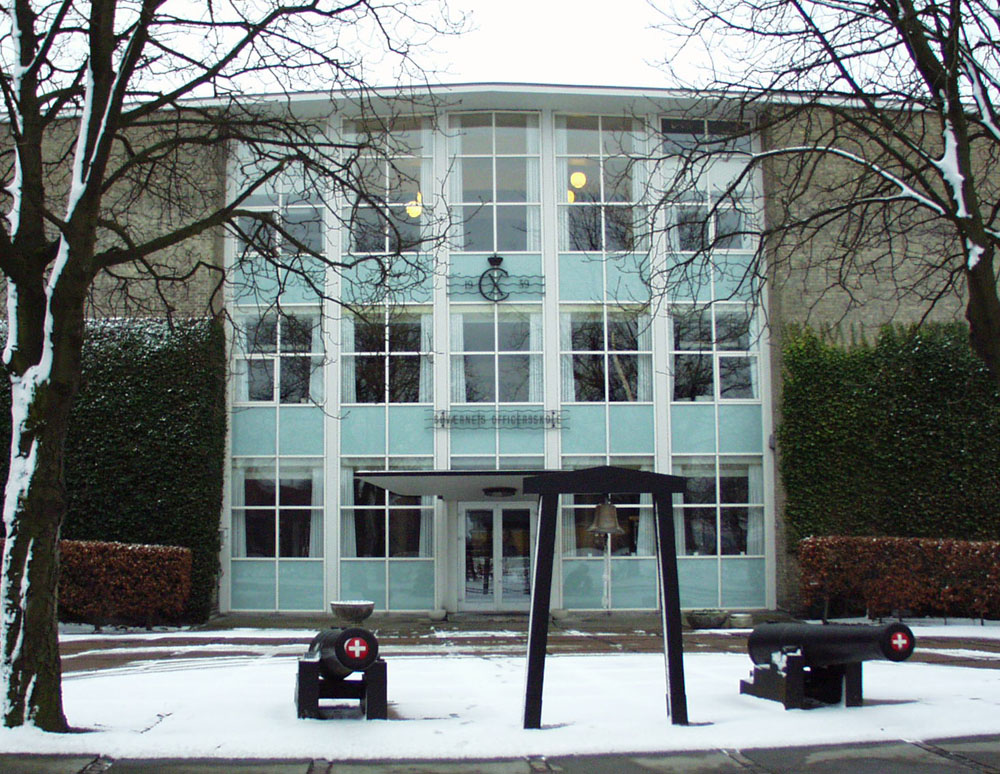- Royal Danish Naval Academy
Infobox University
name = Royal Danish Naval Academy
native_name =
image_size = 250px
caption = Entrance to the academy
latin_name =
motto =Nec Temere, Nec Timide
mottoeng = Neither indecisive nor fearless
established = 1701
closed =
type = Naval academy
affiliation =
endowment =
officer_in_charge = Chr. Nørregaard
chairman =
chancellor =
president =
vice-president =
superintendent =
provost =
vice_chancellor =
rector =
principal =
dean =
director =
head_label =
head =
faculty =
staff =
students =
undergrad =
postgrad =
doctoral =
other =
city =Copenhagen
state =
province =
country =Denmark
coor = coord|55.6862|12.6066|display=inline,title|type:edu
campus = Holmen
former_names = Sø-akademiet, Sø-Cadet-Academiet, Cadetskolen, Søofficersskolen
free_label =
free =
sports =
colors =
colours =
nickname =
mascot =
athletics =
affiliations =
website = http://forsvaret.dk/SOS/
footnotes =The Royal Danish Naval Academy (known in Denmark as "Søværnets Officersskole" or more commonly, "Søofficerskolen") educates and commissions all officers for the
Royal Danish Navy . Having existed in more than 300 years, it is the oldest still existing, officers academy in the world.The education
All
aspirant s (unlike many navies all candidates begin their time as aspirants and then become cadets) begins their education with 6 months of basic military training and generalseamanship . Parts of this at the "Naval NCO and Basic Training School" (Danish: "Søværnets Sergent- og Grundskole") nearFrederikshavn and other parts on the training vessel "Georg Stage" (not to be confused with [Joseph Conrad (ship)|the "Joseph Conrad"). This goes to both aspirants that begins their education without prior military service and those whom is recruited among enlisted and petty officers. Then follows an intensified NCO-training for another 6 months.If these periods are completed and passed, then the aspirant, will move onto the the Naval Academy. Here follows the education for the two functional lines (either the master-line for 4 years or engineering-line for 4½ years). Included in these periods, where the aspirants of each line, is seperated, is also an 11 months leadership training period, where both lines are educated together in courses likeleadership , naval warfare, naval history,teaching ,psychology , administration,social sciences andeconomics . At this time, the aspirant becomes an cadet. After 5-5½ years of training and education from the very start the aspirant is commisioned as an officer.Besides career-officers, the naval academy also trains civilian licensed marine engineers and first officers, towards naval commisioning. This training-period is 11 months for first officers, and 14 months for engineers.
The naval academy also runs the junior staff officers course. This course runs for 11 months, and requires satisfactory service as a OF-1 (danish "premierløjtnant").
History
* January 1701: General-Admirallieutenant Ulrik Christian Gyldenløve proposes the creation of a "Søe Cadet Compagni" (naval cadet company), where young men can receive a training in seamanship, military tactics, navigation with the purpose of becomming naval officers.
* 26th february 1701: King Frederick IV approves the creation of the "Søe Cadet Compagni".: The inspiration was found in the Netherlands and Crance, where a the training of naval officers has been put to system in the 16th century. With the creation of this Company, where also the creation of the second academic education facility in Denmark, only superseeded by theUniversity of Copenhagen (created in 1479). The education facility was initially located at "Bremerholm", close toHolmens Kirke (approx. at the location which now houses the Ministry of Defence).
* 26th april 1701: Commodre C. T. Sehested ajourns as the first chief of "Søe Cadet Compagniet".
* 1709: The "Søe Cadet Compagniet" is renamed to the "Søe Cadet Academiet" (naval cadet academy).
* 1727: The education facility is moved to the 23 year old opera house (the building which now houses the Eastern High Court).
* 1788: The education facility is moved to the northeastern palace (Brockdorff's Palace ) ofAmalienborg Palace .
* 1827: The education facility is moved to the "Søbøtkerske mansion" on the cornor of "Bredgade" and "Esplanaden". A bookstore is now located there in a newer building.
* 1865: The education facality is moved to the former administration complex of the naval artillery on Christiansholm. These buildings still exist and houses the danish naval museeum "Orlogsmuseet" and "The Royal Danish Administration of Navigation and Hydrography" (Danish: "Farvandsvæsnet").
* 1869: The "Søe Cadet Academiet" is renamed to the "Søofficersskolen" (naval officers school) and moves into a facility in Gernersgade inNyboder . This facility was originally build to house a girlschool in 1856. Today the building houses several companies.
* 1903: The "Søofficersskolen" is renamed to "Kadetskolen" (cadet school).
* 1946: The education facility is moved to the current buildings onHolmen naval base . The buildings where already completed in the 1930's, but because of the outbreak ofWorld War 2 and the german occupation of Denmark, the movement is postponed.
* 1951: The "Kadetskolen" is renamed to its current name: "Søværnets Officersskole".
* 1964: The aspirants and cadets, isn't required to live on the school anymore (actually it isn't even possible). These days they are mainly housed by the navy in Nyboder.
* 1966: The naval cadet association ("Søværnets Kadetforening") is created as a social and educational institution.
* 1969: The naval speciality officers school ("Søværnets Specialofficersskole") is disbanded and all education moved to the naval academy.
* 1970: The education is completely restructed and 10 faculties are created.
* 2007: Under the 2005-2009 defence agreement, the naval muscial corps ("Søværnets Tamburkorps") is moved to Holmen and will now be a part of the naval academy as well as all the training facilities on Holmen.Location
The naval academy is located on
Holmen naval base ("Holmen") in centralCopenhagen .Other Danish officers academies
* Army: The
Royal Danish Army Officers Academy ("Hærens Officersskole") located atFrederiksberg Palace in Copenhagen.
* Air force: TheRoyal Danish Air Force Officers School ("Flyvevåbnets Officersskole") located in Jonstrup nearVærløse .
* Emergency Management Agency: TheEmergency Management Officers School ("Beredskabsstyrelsens Center for Lederuddannelse") located atBernstorff Palace inGentofte References
*
*
*
*
*Template group
list =
Wikimedia Foundation. 2010.
